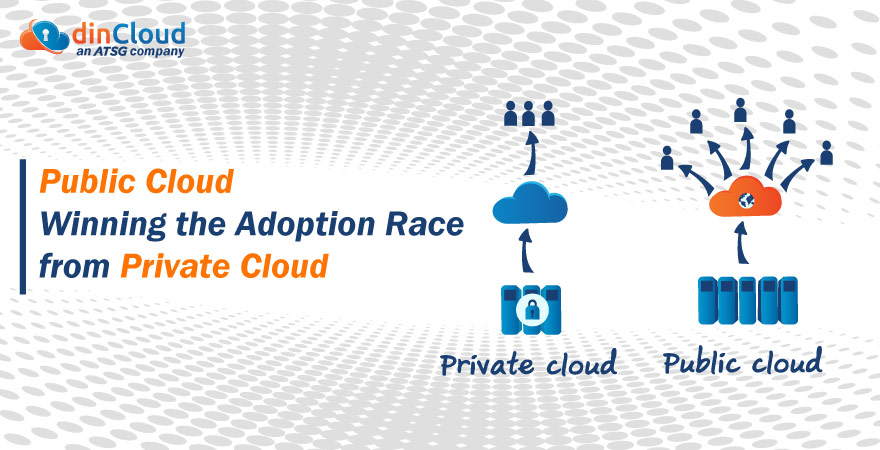Even in the worst days of the global pandemic, businesses had a constant yearn to succeed in cut-throat market competition. Fortunately for many businesses, the expeditious “tech-boom” did give them virtually limitless opportunities to transform their businesses. One such technology that has managed to become a business-favorite is Cloud Computing.
Selection of the right Cloud architecture, one that would be a perfect fit for an enterprise is of paramount value. In the real world, there is no definite “this or that” situation when it comes to deciding in this regard. Enterprises can opt for the Public Cloud, On-premise / Private Cloud technology, or a combination of both, the Hybrid Cloud, depending on their requirements.

In this post, we will weigh the pros and cons of both Public and on-premise Cloud technologies, so that it will be easier for you to decide which model perfectly fits the use case of your enterprise.
Public v/s Private – An Ongoing Debate
Some industry experts are of the opinion that certain applications and IT resources are just too complex or confidential to transfer to the Public Cloud. Enterprises that want to avail the benefits of the Cloud, without going Public, can go for on-premise Cloud. Another term associated with on-premise Cloud is Private Cloud.
There is an exclusive virtualization in the case of Private Cloud, and data centers are usually deployed on-premise. The basic virtualization architectures of both Public and Private Cloud are essentially the same, however, on-premise data centers do sit at the higher end of the price spectrum.
The Director of Private and Hybrid Cloud Solutions at World Wide Technology (WWT), Chris Weis, said that the need to adopt Private Cloud has now increased, and the necessary technical resources are being allocated for this purpose.
That being said, it is important to know that not every organization has the capital or in-house expertise to afford a Private Cloud. Public Cloud offers all the similar advantages, and a few others, at a fraction of the cost, as compared to on-premise Cloud solutions.
Kent Christensen, who is the Practice Director for the Cloud and Data Center Transformation Organization at Insight Enterprise, said that enterprises usually have to spend tons of money to maintain and smoothly run on-premise data centers and related infrastructure.
On-premises Cloud and Co-locations
Paul Wilkinson, who works at 1901 Group as Chief Growth Officer, expressed his opinion that every customer is not willing to go for Public Cloud solutions, and this gap may be filled with on-premise Cloud computing.
Having said that, Paul Wilkinson did agree that in present times, an increasing number of enterprises are preferring Public Cloud services. Out of both the options, the reason for this tilt towards Public Cloud is that Private Cloud is for one particular tenant. This greatly increase capital costs and operating overheads.
According to Wilkinson, Private Cloud resides either in a co-location or data center facility of its customer. These colocations are used as an extended data-center facility that are rented to store servers, manage disaster recovery (DR) and other computing hardware.
Industry specialists view colocation as an alternative to on-premise data center locations, to develop and deploy Private Cloud. Some enterprises build and deploy Private Cloud in colocations themselves, while others let the colocation providers build the Cloud, while they just operate them.
Now, some might say that this resembles the Public Cloud architecture, and the truth is that there is a lot of similarity between the two. In fact, this resemblance is the reason why colocation is becoming so popular in the industry. The problem with colocation is that it is still extremely costly, and there is an acute shortage of skilled IT personnel and experts to effectively run and manage Private Cloud from such facilities.
Other Alternatives to Private Cloud
Multiple Cloud Service Providers (CSPs) have even started extending their services to businesses for the development of Private Cloud. They help businesses develop Cloud solutions within the confines of enterprise networks.
Organizations unwilling to shift legacy applications to the Public Cloud, can leverage data-center-as-a-service models. The question here is that whether “as-a-service data centers” will be able to keep up with the Public Cloud architectures? The short answer to this is No.
The reasons why companies still prefer Public Cloud is that it offers agile and most importantly, scalable storage capacities, computation services and infrastructures, at reduced costs, along with excellent bandwidth and connectivity. Since Public Cloud providers cater to multiple tenants, the sustainability and economies of scale that Public Cloud can achieve is simply un-attainable for Private Cloud.
Related Posts:
- The Public Cloud Market Set to Surpass US $500 BN by 2023
- Why Businesses are Leaving the Big Public Cloud Providers
- Public v/s Private Cloud for Enterprises
- Why are Small Businesses Investing Heavily in the Public Cloud?
Myths Regarding On-premise Cloud Technology
The supporters of on-premise Cloud architectures believe that many enterprises are shifting their workloads from Public Cloud to on-premise systems. The fact remains that the global spending on Public Cloud adoptions is set to grow by 20% in the year 2022. Gartner further predicted that this spending will reach a whopping US $600 billion by 2023.
There has been a significant rise in Public Cloud investment through Channel partners and their customers. Both on-premise cloud technology and Public Cloud services and solutions come with unique benefits that can be leveraged by enterprises.
Conclusion
A pragmatic view of the debate about Public versus Private Cloud clearly shows there is definitely a reason why so many organizations are moving towards the Public Cloud. The final decision boils down to each enterprise’s specific preference. However, it is imperative that post-migration operations must be logically analyzed to avoid the wastage of resources in the future.
Cloud Service Providers (CSP), like dinCloud, provide excellent Cloud-based services and solutions for your enterprise at flat rate pricing, making it a predictable billing model. Our 24/7/365 available customer support team will assist you along every step of the way.


